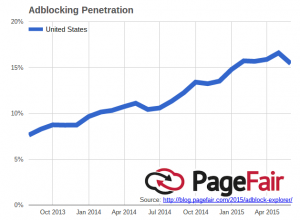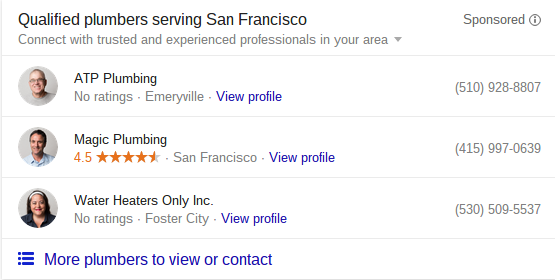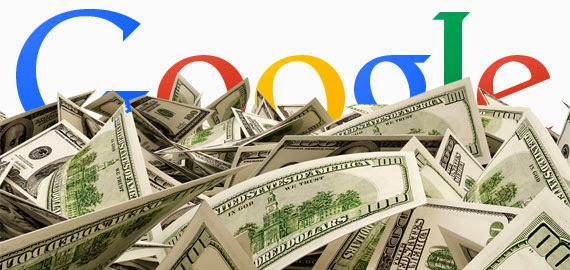August has been a roller-coaster for the stock market, and the small business that earned a majority of website leads from Google organic search.
 There’s no question Google is still king of search engine traffic, with 65% market share. For a majority of small businesses, Google is still the primary means for getting website visitors and therefore leads.
There’s no question Google is still king of search engine traffic, with 65% market share. For a majority of small businesses, Google is still the primary means for getting website visitors and therefore leads.
Typically, local businesses receive over 50% and as much as 80% of all traffic to a website through Google organic search, the non-paying side of Google. No it isn’t free to earn more Google organic traffic, but it doesn’t help Google’s bottom line either.
Sign 1: More Internet Users Adopt Ad Blockers
Investment sites  are taking notice of the adoption of ad blockers by consumers, marking it as a top future threat to Google and Facebook revenue and for good reason. Pagefair has conducted studies into the adoption of ad blocking software, and found an increase of 48% adoption in 2015 for the U.S. That’s right, consumers are using ad blocking software in record rates with an estimated 15% blocking ads currently in the U.S. Apple iOS 9 was announced to have ad blocker automatically enabled, increasing the adoption of ad blocker and further undermining Google’s ad empire.
are taking notice of the adoption of ad blockers by consumers, marking it as a top future threat to Google and Facebook revenue and for good reason. Pagefair has conducted studies into the adoption of ad blocking software, and found an increase of 48% adoption in 2015 for the U.S. That’s right, consumers are using ad blocking software in record rates with an estimated 15% blocking ads currently in the U.S. Apple iOS 9 was announced to have ad blocker automatically enabled, increasing the adoption of ad blocker and further undermining Google’s ad empire.
Sign 2: Google is Shaking up Ad Formats
With less users trusting ads, clicking on ads and implementing steps to block ads completely, Google’s best option is to change the search experience and the format of advertising in Google.
 In early August, Google changed the local map pack worldwide, a source of many unpaid leads to local businesses in nearly every industry. The change was a shift from seven businesses being listed to three businesses. It sounds so minimal, but it will greatly affect how consumers find and purchase from local shops. No longer can a business rank organically for multiple niche service categories. A tire dealer that also offers auto repair services is likely to only rank in Google for one service or the other, not both. The idea being the other service category is advertised via Google Adwords.
In early August, Google changed the local map pack worldwide, a source of many unpaid leads to local businesses in nearly every industry. The change was a shift from seven businesses being listed to three businesses. It sounds so minimal, but it will greatly affect how consumers find and purchase from local shops. No longer can a business rank organically for multiple niche service categories. A tire dealer that also offers auto repair services is likely to only rank in Google for one service or the other, not both. The idea being the other service category is advertised via Google Adwords.
At the same time, Google is experimenting in San Francisco with new ads that mimic Google organic results for the home services category. HVAC contractors, plumbers, locksmiths and more are offered a new ad format that allows consumers to send quotes for service to multiple paying advertisers. Google also allowed for reviews, a badge of honor for many local businesses and a top contributor to earning more organic traffic, to be displayed in Google Adwords.
All of these moves are aimed at increasing the spend of local businesses in Adwords, deceasing the % of traffic from Google organic search, and increasing the number of customers that click on ads.
Sign 3: Competition Increasingly Selling Leads to Local Businesses
 With the death of a physical yellow pages due to the search engine age, YP, Yellow Book, the BBB and other local business directories have moved to the internet, still keeping clients and preventing money from going to Google Adwords. Other directories popped up only several years ago such as Yelp, and ever since Google has defended its turf. I’ve covered this much more in depth on the difference between a lead on yp.com and Google, but the short answer is these directories have organic visibility in Google, for some markets and industries. They also sell leads to local businesses, money that could be going towards Google Adwords.
With the death of a physical yellow pages due to the search engine age, YP, Yellow Book, the BBB and other local business directories have moved to the internet, still keeping clients and preventing money from going to Google Adwords. Other directories popped up only several years ago such as Yelp, and ever since Google has defended its turf. I’ve covered this much more in depth on the difference between a lead on yp.com and Google, but the short answer is these directories have organic visibility in Google, for some markets and industries. They also sell leads to local businesses, money that could be going towards Google Adwords.
However, multiple competitors have sprung up in recent years, all aimed at selling leads
to local businesses, many in specific niches like Homeadvisor for the home services market. Others are small, harmless and in Google’s control. Thumbtack.com is an example, backed by Google ventures, and with increased visibility for many local keywords.
Amazon services however, poses a real threat to Google’s advertising machine. Still largely unknown to many consumers and with little advertising push to date, the ability to purchase local services from the same company many of us purchase everything else should be seen as a thorn in Google’s model.
For all these reasons, Google is constantly tweaking the search experience, attempting to maximize revenue while still keeping users happy.


 Corey is an independent digital consultant for agencies and clients throughout Texas. When he isn't thinking about the internet of things, he is a connoisseur of fine beer, traveling, indie music and is currently learning the bagpipes.
Corey is an independent digital consultant for agencies and clients throughout Texas. When he isn't thinking about the internet of things, he is a connoisseur of fine beer, traveling, indie music and is currently learning the bagpipes.

